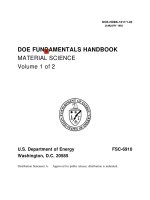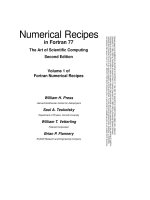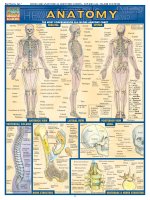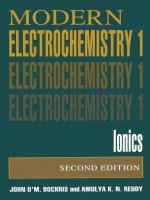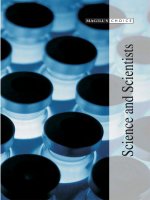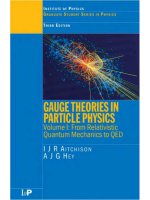Corrosion vol 1 metal environment reactions 3ed 1994 shreir, jarman burstein
Bạn đang xem bản rút gọn của tài liệu. Xem và tải ngay bản đầy đủ của tài liệu tại đây (32.78 MB, 1,432 trang )
‘7
ORLGSION
Metal/
Environment
.
Reactions
L
third edition
CORROSION
Volume I
MetaVEnvironment Reactions
Edited by
L.L. Shreir, PhD, CChem, FRIC, FIM, FICorrT,
FIMF, OBE
R.A. Jarman, MSc, PhD, CEng, MIEE, FIW
G.T. Burstein, MSc, PhD, M A
1
E I N E M A N N
Butterworth-Heinemann
Linacn House, Jordan Hill, Oxford OX2 8DP
225 Wildwood Avenue, Wobum, MA 01801-2041
A division of Reed Educational and Professional Publishing Ltd
-&member
of the Reed Elsevkr plc group
OXFORD AUCKLAND BOSTON
JOHANNESBURG MELBOURNE NEW DELHI
First Published 1963
Second edition 1976
Third edition 1994
Reprinted 1995, 1998,2000
0 The several contributors listed on pages xviii-xxii, 1963, 1976, 1994
All rights reserved. No part of this publication
may be reproduced in any material form (including
photocopying or storing in any medium by electronic
means and whether or not transiently or incidentally
to some other use of this publication) without the
written permission of the copyright holder except in
accordance with the provisions of the Copyright,
Designs and Patents Act 1988 or under the terms of a
licence issued by the Copyright Licensing Agency Ltd,
90 Tottenham Coun Road, London, England W IP OLP.
Application for the copyright holder's written permission
to reproduce any part of this publication should be addressed
to the publishers
British Library Cataloguing in Publication Data
Corrosion - 3Rev.ed
I. Shreir. L. L. 11. Jarman, R. A.
111. Burstein, G. T.
620. I623
Library of C o n g m s Cataloguing in Publication Data
Corrosionledited by L. L. Shreir, R. A. Jarman. G . T. Burstein
p. cm.
Includes bibliographical references and index.
Contents: v. I . MetaVenvironmental reactions - v. 2. Corrosion control
I . Corrosion and anti-corrosives. 1. Shreir, L. L.
11. Jarman, R. A. 111. Burstein, G. T.
TA462.C6513 1993
93- I3859
620.1 ' 1223-dc20
ISBN 0 7506 1077 8 (for both volumes)
CIP
Printed and bound in Great Britain
FOR E V E N T m B THAT WE PUBLISH, B ~ O R T H N E W M A N N
W U PAY POR BTCV TO W A N D CAR8 FOR A T I W .
CONTENTS
Volume 1 . MetaVEnvironment Reactions
L. L. Shreir, OBE
Preface to the third edition
Preface to the first edition
List of contributors
1. Principles of Corrosion and Oxidation
1.1
Basic Concepts of Corrosion
1.1A
Appendix - Classification of Corrosion Processes
1.2
Nature of Films, Scales and Corrosion Products on Metals
1.3
Effects of Metallurgical Structure on Corrosion
1.4
Corrosion in Aqueous Solutions
1.5
Passivity and Localised Corrosion
1.6
Localised Corrosion
1.7
Bimetallic Corrosion
1.8
Lattice Defects in Metal Oxides
1.9
Continuous Oxide Films
1.10
Discontinuous Oxide Films
1.11
Erosion Corrosion
2. Environments
2.1
Effect of Concentration, Velocity and Temperature
V
vi
CONTENTS
2.2
The Atmosphere
2.3
Natural Waters
2.4
Sea Waters
2.5
Soil in the Corrosion Process
2.6
The Microbiology of Corrosion
2.7
Chemicals
2.8
Corrosion by Foodstuffs
2.9
Mechanisms of Liquid-metal Corrosion
2.10
Corrosion in Fused Salts
2.11
Corrosion Prevention in Lubricant Systems
2.12
Corrosion in the Oral Cavity
2.13
Surgical Implants
3. Ferrous Metals and Alloys
3.1
Iron and Steel
3.2
Low-alloy Steels
3.3
Stainless Steels
3.4
Corrosion Resistance of Maraging Steels
3.5
Nickel-Iron Alloys
3.6
Cast Iron
3.7
High-nickel Cast Irons
3.8
High-chromium Cast Irons
3.9
Silicon-Iron Alloys
3.10
Amorphous (Ferrous and Non-Ferrous) Alloys
CONTENTS
4. Non-Ferrous Metals and Alloys
4.1
Aluminium and Aluminium Alloys
4.2
Copper and Copper Alloys
4.3
Lead and Lead Alloys
4.4
Magnesium and Magnesium Alloys
4.5
Nickel and Nickel Alloys
4.6
Tin and Tin Alloys
4.7
Zinc and Zinc Alloys
5. Rarer Metals
15.1
Beryllium
5.2
Molybdenum
5.3
Niobium
5.4
Titanium and Zirconium
5.5
Tantalum
5.6
Uranium
5.7
Tungsten
6. The Noble Metals
6.1
The Noble Metals
7. High-Temperature Corrosion
7.1
Environments
7.2
The Oxidation Resistance of Low-alloy Steels
7.3
High-temperature Corrosion of Cast Iron
vii
viii
CONTENTS
7.4
High-alloy Steels
7.5
Nickel and its Alloys
7.6
Thermodynamics and Kinetics of Gas-Metal Systems
8. Effect of Mechanical Factors on Corrosion
8.1
Mechanisms of Stress-corrosion Cracking
8.2
Stress-corrosion Cracking of Ferritic Steels
8.3
Stress-corrosion Cracking of Stainless Steels
8.4
Stress-corrosion Cracking of High-tensile Steels
8.5
Stress-corrosion Cracking of Titanium, Magnesium and
Aluminium Alloys
8.6
Corrosion Fatigue
8.7
Fretting Corrosion
8.8
Cavitation Damage
8.9
Outline of Fracture Mechanics
8.10
Stress-corrosion Test Methods
8.10A Appendix
- Stresses in Bent Specimens
Volume 2. Corrosion Control
Introduction to Volume 2
9. Design and Economic Aspects of Corrosion
9.1
Economic Aspects of Corrosion
9.2
Corrosion Control in Chemical and Petrochemical Plant
9.3
Design for Prevention of Corrosion in Buildings and Structures
9.4
Design in Marine and Offshore Engineering
9.5
Design in Relation to Welding and Joining
9.5A
Appendix - Terms Commonly Used in Joining
10. Cathodic and Anodic Protection
10.1
Principles of Cathodic Protection
10.2
Sacrificial Anodes
10.3
Impressed-current Anodes
10.4
Practical Applications of Cathodic Protection
10.5
Stray-current Corrosion
10.6
Cathodic-protection Interaction
10.7
Cathodic-protection Instruments
10.8
Anodic Protection
ix
CONTENTS
X
11. Pretreatment and Design for Metal Finishing
11.1
Pretreatment Prior to Applying Coatings
11.2
Pickling in Acid
11.3
Chemical and Electrolytic Polishing
11.4
Design for Corrosion Protection by Electroplated Coatings
11.5
Design for Corrosion Protection by Paint Coatings
12. Methods of Applying Metallic Coatings
12.1
Electroplating
12.2
Principles of Applying Coatings by Hot Dipping
12.3
Principles of Applying Coatings by Diffusion
12.4
Principles of Applying Coatings by Metal Spraying
12.5
Miscellaneous Methods of Applying Metallic Coatings
13. Protection by Metallic Coatings
13.1
The Protective Action of Metallic Coatings
13.2
Aluminium Coatings
13.3
Cadmium Coatings
13.4
Zinc Coatings
13.5
Tin and Tin Alloy Coatings
13.6
Copper and Copper Alloy Coatings
13.7
Nickel Coatings
13.8
Chromium Coatings
13.9
Noble Metal Coatings
14. Protection by Paint Coatings
14.1
Paint Application Methods
CONTENTS
14.2
Paint Formulation
14.3
The Mechanism of the Protective Action of Paints
14.4
Paint Failure
14.5
Paint Finishes for Industrial Applications
14.6
Paint Finishes for Structural Steel for Atmospheric Exposure
14.7
Paint Finishes for Marine Application
14.8
Protective Coatings for Underground Use
14.9
Synthetic Resins
14.10
Glossary of Paint Terms
15. Chemical Conversion Coatings
15.1
Coatings Produced by Anodic Oxidation
15.2
Phosphate Coatings
15.3
Chromate Treatments
16. Miscellaneous Coatings
16.1
Vitreous Enamel Coatings
16.2
Thermoplastics
16.3
Temporary Protectives
17. Conditioning the Environment
17.1
Conditioning the Atmosphere to Reduce Corrosion
17.2
Corrosion Inhibition: Principles and Practice
17.3
The Mechanism of Corrosion Prevention by Inhibitors
17.4
Boiler and Feed-water Treatment
xi
xii
CONTENTS
18. Non-Metallic Materials
18.1
Carbon
18.2
Glass and Glass-ceramics
18.3
Vitreous Silica
18.4
Glass Linings and Coatings
18.5
Stoneware
18.6
Plastics and Reinforced Plastics
18.7
Rubber and Synthetic Elastomers
18.8
Corrosion of Metals by Plastics
18.9
Wood
18.10
The Corrosion of Metals by Wood
19. Corrosion Testing, Monitoring and Inspection
19.1
Corrosion Testing
19.1A Appendix - Removal of Corrosion Products
19.1B Appendix - Standards for Corrosion Testing
19.2
The Potentiostat and its Applications to Corrosion Studies
19.3
Corrosion Monitoring and Inspection
19.4
Inspection of Paints and Painting Operations
20. Electrochemistry and Metallurgy Relevant to Corrosion
20.1
Outline of Electrochemistry
20.2
Outline of Chemical Thermodynamics
20.3
The Potential Difference at a Metal/Solution Interface
20.4
Outline of Structural Metallurgy Relevant to Corrosion
CONTENTS
21. Useful Information
21.1
Tables
21.2
Glossary of Terms
21.3
Symbols and Abbreviations
2 1.4
Calculations Illustrating the Economics of Corrosion
Index
...
Xlll
1.1. SHREIR, OBE 1914-1992
Lionel Louis Shreir OBE, died on 5th November 1992 after a lifetime
devoted to the science and technology of corrosion and education. His
industrial career spanned a period of 19 years, from 1929 to 1948, during
which time he was employed by the Mond Nickel Company, Baker Platinum
Ltd and Plessey Ltd. At the same time he continued his higher education on
a part time basis at the Chelsea and Battersea Polytechnicsand Sir John Cass
College in London. In 1948, he joined the staff of Battersea Polytechnic,
subsequently renamed the University of Surrey, eventually attaining the
position of Reader in Corrosion. In 1%2 Lionel became Head of Metallurgy
of the Sir John Cass College (now London Guildhall University), a post he
enjoyed by greatly expanding the Department, its research and general
reputation until his retirement in 1979.
Lionel’s contribution to corrosion was outstanding. In addition to his
encyclopedic work Corrosion, the present edition being dedicated to his
memory, he was author of more than 70 papers and was editor of Corrosion Science for many years. He was engaged as a consultant to a number
of organisations up to the time of his death whilst his research initiatives
covered many fields, including hydrogen in metals, anodic oxidation and
electrodeposition. He was the third recipient of the U.R. Evans Award in
1978 and was awarded the OBE in 1982 in recognition of his services to
corrosion. In this context, one of his most notable activities was to advise
on the protection of the Thames Barrier. In the past year a Lionel Shreir
Award was awarded for the first time by the Institute of Corrosion Science
and Technology.
Regardless of his achievements Lionel was kind, modest and a very caring
man. He will be affectionately remembered for his boundless energy and
infectious enthusiasm by his peers, colleagues, friends and the countless
past students privileged to have made his acquaintance during what was a
R A JARMAN
remarkably active life.
xv
The huge success of the first two editions of Corrosion has inevitably created
the demand for a third edition. Corrosion science and technology, like most
of the physical sciences, has progressed and advanced significantly in the
seventeen years since the second edition was published. Such knowledge
requires transferral from the laboratory and the journal literature to the
wider audience: the student, the teacher, the engineer, the metallurgist and
workers in other fields who require knowledge and understanding of the
interactions of materials with their environments. The previous two editions,
the fruits of Lionel Shreir’s hard labours, have fulfilled this multiple role
admirably and the new editors hope that this new edition will continue to do
so. The fact that Lionel worked so hard on producing the third edition but
did not live to see its publication, is a personal and deeply poignant sorrow
for us, as it must be for the many readers of Corrosion who knew and
respected him as scientist and friend.
The ever-increasing research into corrosion, and the knowledge that this
produces is driven to a small part by the corrosion scientist him- or her-self
in seeking a detailed understanding of the intricacies of the interfacial processes driving corrosion and passivation. Such a self-fulfilling drive cannot
of itself however, be indefinitely sustainable, despite the fascination that this
science engenders, since research is costly. Such advances are led primarily
by the continuing need to predict, control and prevent corrosion as an
engineering imperative. Corrosion science, multidisciplinary in itself, is probably unique in crossing the borders of almost all the technologies:
environmental stability of all components of those technologies remains a
prime requirement for their success. New technologies, new engineering practices, new materials and new processes can succeed only if the behaviour of
their components with the environment is satisfactory, and predictably so.
The eighties and nineties, and beyond, see a further need to underpin research
and development into corrosion and protection - the growing awareness of
the necessity for conservation, of materials and of energy, the so-called green
issues. Most materials and components made from them require large energy
resources to produce; clearly the quest for longevity and reliability of structures is a significant and worthy contribution towards conserving energy and
materials, quite additional to minimising the heavy cost of corrosion failures.
As with the second edition, the new volumes have been revised according
xvi
PREFACE TO THE THIRD EDITION
xvii
to the general format and structure of their antecedents. Some sections have
been completely rewritten to bring them up to date, while others have been
altered and extended. New sections have been included to cover areas not
previously treated. The incorporation of new authors to carry out such revisions and additions is the inevitable consequence of the fact that thirty years
have elapsed since Corrosion first appeared. The multiplicity of authors for
the new edition leads (as with previous editions) to a variety of styles of
writing and variation in treatment and emphasis of subject matter. One
hopes this is beneficial to the work in providing a broader cross-section of
corrosion science and technology as a whole: it is for the reader and casual
user to judge. One hopes too, that the third edition remains a tribute to the
man who initiated Corrosion.
GTB
Cambridge
The enormous scope of the subject of corrosion follows from the definition
which has been adopted in the present work. Corrosion will include all reactions at a metal/environment interface irrespective of whether the reaction
is beneficial or detrimental to the metal concerned -no distinction is made
between chemical or electropolishing of a metal in an acid and the adventitious deterioration of metal plant by acid attack. It follows, therefore, that
a comprehensive work on the subject of corrosion should include an account
of batteries, electrorefining, chemical machining, chemical and electrochemical polishing, etc.
The fact remains, nonetheless, that the environmental reaction of a metal
used as a construction material is the most important type of corrosion reaction, and the one of most concern to the engineer. The technological and
economic consequences of the wastage of metals by corrosion are now fully
appreciated, and figures have been published which show the enormous financial losses, both to the individual organisation and to the economy of the
country as a whole, resulting from the deterioration of metals. The need for
conserving metals has been publicised by Dr U. R. Evans, Dr J . C. Hudson,
Mr T. H. Turner, Professor H. H. Uhlig, Dr W.H. J. Vernon, and others,
and the ‘corrosion consciousness’ which prevails today is largely due to their
efforts.
In the light of what has been said above, little further explanation of the
implications of the title of the present work is required. Its treatment of the
subject of corrosion will centre round the control of the environmental interactions of metals and alloys used as materials of construction.
The effective control of corrosion reactions must be based on an understanding of the mechanism of such reactions and on the application of this
knowledge to practical problems. The work, regarded as a whole, represents
an attempt, therefore, to present the subject of corrosion as a synthesis of
corrosion science and corrosion engineering. Thus in the planning of the
content an attempt has been made to strike a suitable balance between the
primarily scientific and the primarily practical aspects, and so the nature of
individual sections ranges from the fundamental and theoretical to the essentially practical.
It is hoped that this approach has resulted in a work that will be of some
xviii

